Part 8 - Solar Power - Expanded
We still need solar power if we are in a shady spot
Welder Cables? Who knew?
 We found ourselves going through Quartzite, NM, a wintering ground for many boondocking campers using alternative energy to live disconnected. SOLAR BILL, the friendly sign said, so we pulled in, pushed through their several huge and beautiful macaws, and asked him to look at our homemade setup.
We found ourselves going through Quartzite, NM, a wintering ground for many boondocking campers using alternative energy to live disconnected. SOLAR BILL, the friendly sign said, so we pulled in, pushed through their several huge and beautiful macaws, and asked him to look at our homemade setup.
The good news was they were very impressed that I wired the inverter power into all the outlets in the coach while bypassing the refrigerator so it would still run on LP gas and not drain the battery system unnecessarily.
Atta me!
The bad news was that our standard battery cables were too small to feed enough power from the battery bank to the inverter - we were missing a lot of power we already had!
But, but…. I used the biggest gauge battery cables! Nope, it turns out I should have used welders cables, see? What? Who knew???
Well, they replaced them all and suddenly we were able to run the coffee maker and microwave and the A/C fan - even the A/C cooling for a few minutes without overloading the power stream! Whoa!
So, this improved capacity renewed my interest in our renewable power possibilities.
Over the next couple months, I replaced the one battery that had failed and contacted our original solar company to add more panels to our existing roof system. NO GO! They not only said that our type of 21.5V 100w 4.54 amp panels had been discontinued but that our MPPT solar charge controller was already maxed out with our 4 panels! They said the best solution was to now add a complete 2nd system with a new controller and new panels and just hook the 2nd system up to the batteries at the same place with the first. No! I was irritated because I originally thought our system from them was expandable and if I was going to have to add a complete 2nd solar system, I figured I could do better. Hmmm. We’ll see.
Expanding our Options to include Primitive Camping in Forests
We went to this primitive campground for 3 weeks in the trees within the Kings Canyon and Sequoia National Forest area at Hume Lake. We have always avoided forests with primitive (i.e. no hookup of electric or water or sewer) campgrounds. Although we are good for about a week on our water and sewer, we need at least sunlight for power if we and our mostly tent-camping neighbors don’t want to be listening to our generator running all day! Kinda ruins the ambiance, y’know? Having access to the southern sky for our satellite TV is preferred but not absolute since we have lots of recordings.

Our campsite had sun on our roof solar panels for maybe 4 hours a day. The rocker foot mounts for the solar panels are glued to the roof using VHB (Very High Bond) 3M tape so we did not have to drill the roof. They only weigh 20 lbs. each, so I angled AND moved the solar panels around on the roof a few times during the day as the sun and tree shadows crossed the clearing we were at the edge of. That at least got us absolute minimum power for working on all the computers, a little cooking and some TV. Plus, our charcoal grill was outlawed because of the California drought and wildfires. But we loved it there!
Each day I noticed the sun was brightest for the longest in the clearing next to us where our picnic table was and tent space was intended. Hmmmm….. If I had lightweight, storable solar panels I could just put them over there and run a wire back to the RV….
After we got back to the ranch in Oakley, one of my searches for flexible solar panels came up with some18 foot long rolls of commercial, flexible 24 volt, 144 watt solar panels, each weighing 16 lbs., made for warehouse and factory roofs with MC4 quick connect cables at one end and roof tar/glue on the back. The manufacturer had gone out of business and their inventory was on Amazon - no service help, just specs. I could get 3 of them for $251 each, more than doubling our solar capacity. Then just lay them out in any nearby sunlight!
From the product description: “Each UNI-SOLAR module utilizes triple-junction amorphous silicon solar cells. The blue, green, and red light of the sun is absorbed in different layers of the cell, yielding higher energy production, especially at low insolation levels and under diffused light. Shadow Tolerant. By-pass diodes are connected across each cell allowing the laminates to produce electricity even when partially shaded or soiled. High Temp Performance. In real-world conditions module temperatures can be up to 185 degrees. The performance of crystalline silicon cells declines significantly in high temperatures, while UNI-SOLAR amorphous silicon technology does not.”
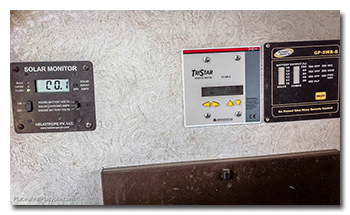 OK - maybe I could figure this out. I needed to find an MMPT adjustable charging controller like ours (it HAS kept our batteries alive for over 5 years!), make sure it could handle much more than the total watts of the new rolls combined and accept 24 volt and the same connectors and, and….. all the stuff I could read.
OK - maybe I could figure this out. I needed to find an MMPT adjustable charging controller like ours (it HAS kept our batteries alive for over 5 years!), make sure it could handle much more than the total watts of the new rolls combined and accept 24 volt and the same connectors and, and….. all the stuff I could read.
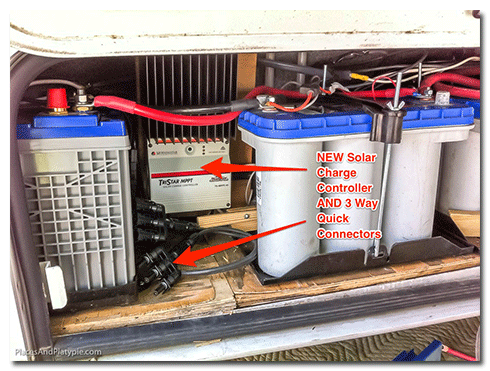
Kids, at some point in your research, when nobody has done this before, you just have to take the leap with your best judgement. I went with a bigger than needed (for later expansion) Morningstar TS-MPPT-45 TriStar 45 Amp Charge Controller which handles 12-48V input and has a remote Digital meter to mount in the wall with our other meters.
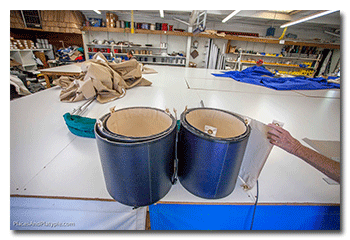 I mounted the controller in the battery compartment wired to the first and last post in our battery bank, just like our existing solar controller was wired.
I mounted the controller in the battery compartment wired to the first and last post in our battery bank, just like our existing solar controller was wired.
 One short cable is dropped out the battery door from the controller to the panels, the other longer cable went to the roof. That way, I was able to connect some or all to either place and be ready with a connection to expand to the roof with more panels later.
One short cable is dropped out the battery door from the controller to the panels, the other longer cable went to the roof. That way, I was able to connect some or all to either place and be ready with a connection to expand to the roof with more panels later.
I got six 50ft extension cables with male and female ends to make 3 dual dual 50’ cables to reach the panels 50’, 100’ or 150’ away from the RV and some 3 to 1 connectors to attach the panels.
I took the rolls to a boat canvas and sail company to add a backing to cover the glue adding grommets along the edge to hang or join the rolls together.
However, once laid out in the sun, the black tar-like glue just dripped out of the sides so I edged each roll with monster tape starting on the front at the edge of the active solar cells then wrapping it over to the back.
This has worked great.
We first tested the flex roll system at Wright’s Beach in California, then at a high country primitive campground in Fish Lake Forest, Utah. We tried draping them from the roof but the best arrangement seemed to be rolling them out on the ground side by side then moving them for best effect twice as the day went by - maybe tying them to a tree or fence to achieve the best angle to the sun.

The results were great! Both MPPT charge controllers upped the output of the solar panels and the breeze off the cool Pacific Ocean meant no need for air conditioning so, perfect conditions!
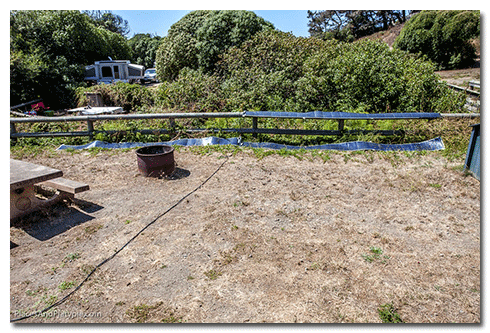 Here are some readings at my current level of understanding:
Here are some readings at my current level of understanding:
Fog or Overcast:
- Our 4 roof mounted, 100w, 21.5v vpm solar panels put out 7.6 amps = 163 watts.
- Our 3 new 144w, 24v flex-panel rolls put out 7.9 amps = 189.6 watts
- Total: 542.6 watts
This was enough to keep the batteries charged for the evening activities and work the basics and computers and TV off and on all day as needed.
At Maximum Sun:
- Our 4 roof mounted, 100w, 21.5v vpm solar panels put out 23 amps = 494.5 watts.
- Our 3 new 144w, 24v flex-panel rolls put out 25 amps = 600 watts
- Total: 1,094.5 watts
In full sun, we could run all the computers while cooking in the rice steamer for hours and have full batteries for the evening!
RV Plug-in Shore Power at a Campground:
A 120v, 30 amp RV electric outlet produces:
3,600 watts
In other words, on a sunny day, we’re about a third of the way there.
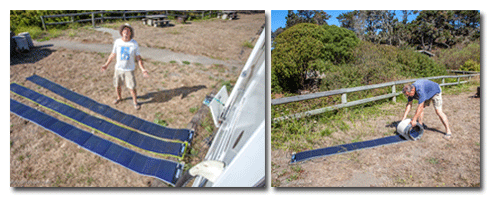
So, a whole new world of really kool and really inexpensive camping locations has opened up to us!

The rolls are stacked and rolled together and stored in our storage box on the back of the RV.



The grommets on the vinyl backing we added allow us to attach the panels to trees, fences - anything to optimize sun!
Now I need to somehow get with some engineers working in solar and battery technologies to really experiment with an ideal mobile deployment of new power technologies. In the coming age of universal connectivity, this lifestyle of ours - enjoying living across the entire country - will become much more widespread, requiring independent, reliable power.
Fabulous!!! Now when will they make solar clothing?
Sukey
Mr. Tesla would be proud of you.
Jon C
You both are amazing.
Tina H
Awesome! That is all I can say, since the technology is too comlicated for me to understand. Good luck on your travels and finding very interesting new places.
Ilo-Mai
I read it all and still dont understand anything.
Tony


